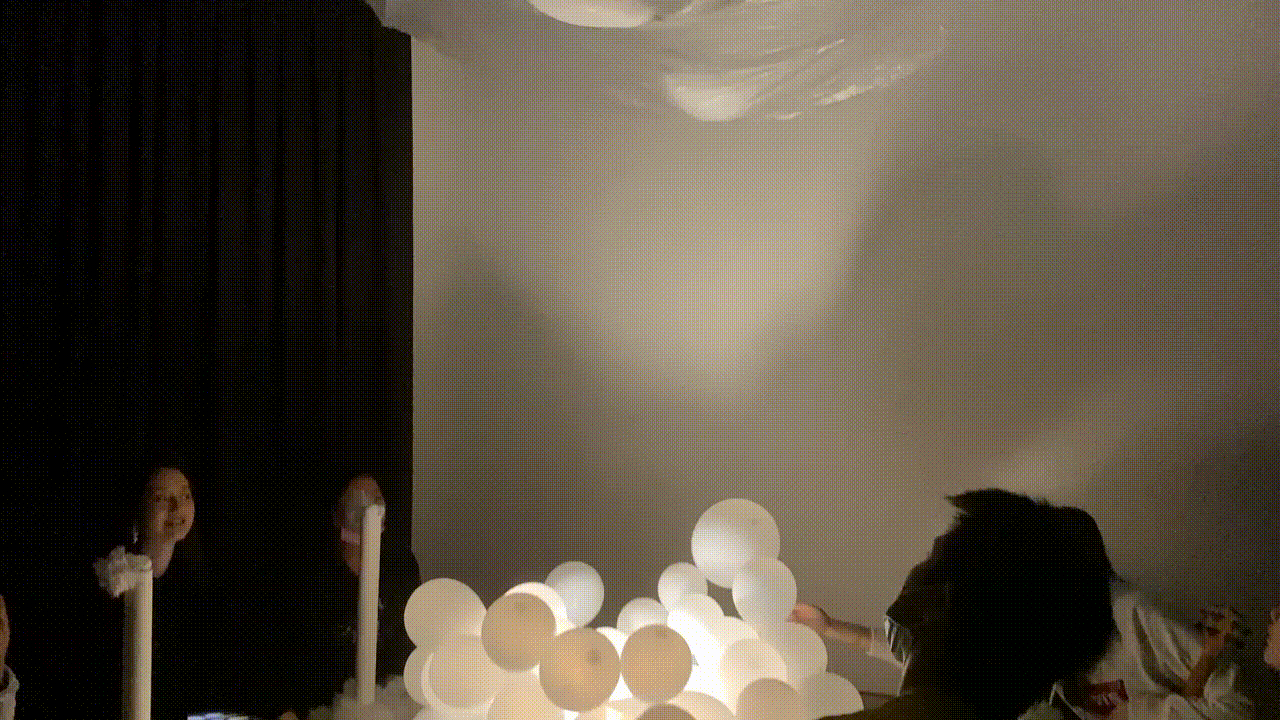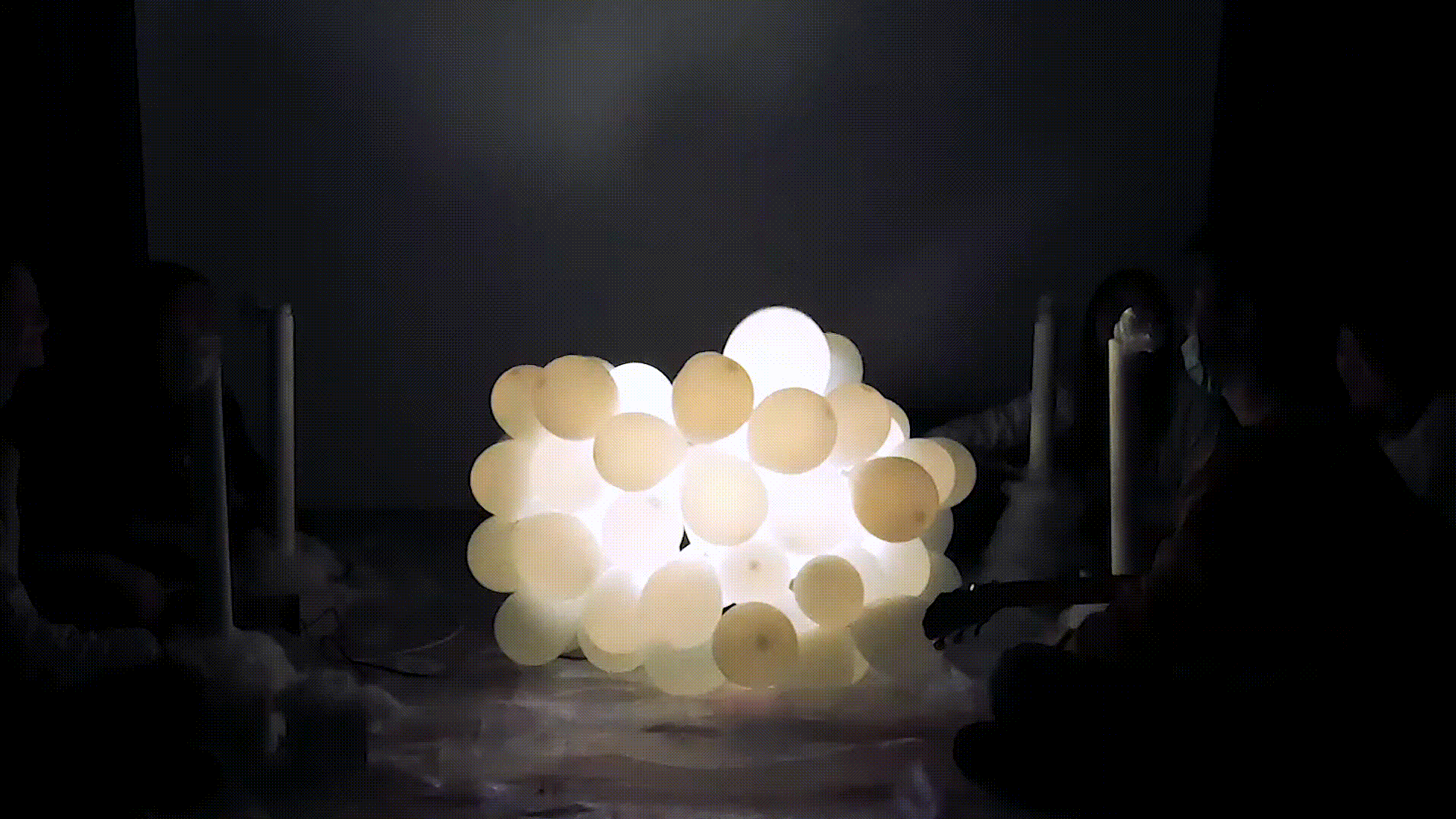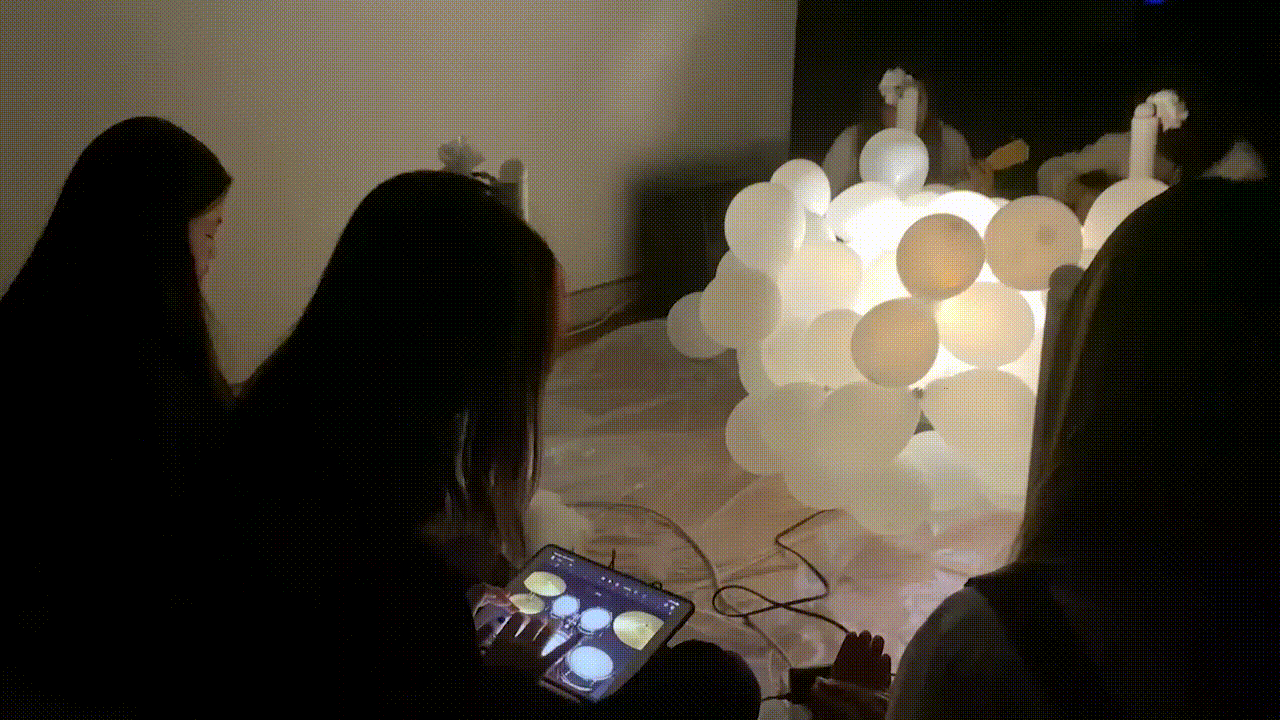
CBreath
CBreath presents a new way of using collaborative breathing to create connectedness between the jam session participants, externalizing their synchronized breathing by multi-sensory experiences via light and wind mediated by technology. The “C” in CBreath stands for “Collaboration”, “Connection” and “Consciousness”, which means that this experience is a collaborative experience of creating the feeling of connections through participants’ conscious breathing.
Designers: Ines Ziyou Yin & Vanessa Keiun Van
Instructor: Dr. John Fass
Duration: 21st June - 12th November 2021
Research Focus
Investigating the experience-oriented design of technology.
I explored the potential of developing technological artifacts that incorporate collaborative breathing for mediating connectedness based on people’s expected experiences.
Main Finding
With the research focus, I evaluated whether and how speculative co-design approaches can help with generating an experience-oriented technological artifact that prioritized people’s feelings and experiences so that people would accept and be willing to interact with it.
Through this research-led design, I demonstrated the potential of incorporating speculative co-design approaches like speculative co-design workshops and user testing in the experience-oriented design of technology to create interpersonal connectedness.
My Contribution
-
Literature Review
-
Research Through Design
-
Co-design Workshop
-
Design Synthesis
-
Coding
-
Prototyping
-
User Testing
-
Stage Design
-
Video Shooting and Editing


Design
CBreath is a technological-mediated collaborative breathing experience capable of linking five to ten musicians in a jam session. The experience was designed to include a collaborative breathing ritual for building the connectedness between the musicians and an improvised performance following the ritual. The bases of the whole experience consist of the designed technological artifact that supported the whole experience, as well as the aesthetic and stage design.
01
Technological Artifact
The supportive technological artifact for the CBreath experience is a wireless breathing cyborg. It incorporates four sets of breathing machines (each consisting of a sound sensor that detects people’s breathing rates and a fan that gives out a joint outcome of the synchronized breathing), a set of central controllers which could receive the signals from each machine and provide feedback on whether the breathing is synchronized to each machine, a big fan, and a color-changing light.
Since the four machines and the central controller were assembled using an Arduino ESP32S WiFi board respectively, they could be placed separately in different spots within the same space.
Once the breathing of all participants is synchronized, the fan system will be activated, along with the light turning warm white and balloons falling. The multi-sensory chain reactions, at the same time, support the creation of interpersonal connectedness between jam session participants.
02
Aesthetics and Stage Design
The aesthetic design takes inspiration from the metaphors related to breathing, such as “dandelion”, “clouds”, and “waving and inflating things”.
The sound sensors are designed into the form of a flower. The stands for the sound sensors and the boxes for the fans are decorated using cotton and the big fan at the center of the stage is covered by balloons, which look like clouds. At the same position as the big fan was a light that could change colors according to the state of the synchronicity of the people, while on the top of the stage hangs a piece of fabric containing serval balloons, which can react to the blowing winds from the big fan at the center.





03
Experience
When experiencing CBreath, participants sit down in a circle, with four of them each facing a breathing machine.
When the experience begins, everyone starts the collaborative breathing ritual by feeling their own and each other’s breath in a quiet environment. They would try to synchronize their breathing with the help of the color-changing light as a visual cue.
Once the participants’ breathing synchronize, the fan system (the four small fans and the big one) would be activated, along with the light turning warm white. As the fans are activated, the participants could feel the wind from the side, and at the same time, the fabric at the top was blown by the wind, which caused the balloons above to fall.
Such real-time, multi-sensory feedback of the synchronized breathing could make people feel the internal connections between each other, so as to establish the connectedness. The participants could then play with the balloons together and gradually begin their improvised jam session. The experience will naturally end when the participants have experienced a pleasant collaboration.



Methodology
Speculative co-design workshops, prototyping, and testing with participants were the three main methods we used in different stages referring to the concept of co-design.
The triangle shows how the speculative co-design workshops and the prototyping and testing led to the final design in this project, while the circle illustrates how the two rounds of ideation, generation, evaluation, and optimization iterate with these methods.


First Round: Identifying design context and testing different possibilities
01 Speculative Co-design Workshop
The first speculative co-design workshop was conducted after initial primary and secondary research on breathing and technologies for connectedness. This workshop aimed to figure out the missing experiences in people’s use of current technologies for supporting connectedness and to encourage people to speculate on the experiences related to breathing that they would want for connecting with others.
There were eight participants from different backgrounds in the workshop, such as computer science, neuroscience, and design.


Participants write down their speculated future of possible experiences and supported technologies.

The prototype is designed for supporting the private conversation between two people during a meeting.

The prototype is designed for supporting the need of touching and hugging the other party in a long-distance relationship.

The prototype is designed for two or more people to transfer information by modeling 3D artifacts but not just 2D flattened mediators.

This is the prototype about a TUI game that can afford the couples or family members to jointly create artifacts to record a period of history.


Participants write down their speculated future of possible experiences and supported technologies.

The prototype illustrate the possible experience of using a cushion to mimic the posture or gesture of another people's

The prototype presents a possibility to remotely transmit the information about the emotions and moods through a long distance between 2 people.
Key Findings
Through the speculation and designs of the participants in the workshop, we found a gap in the current designs in the context of jam sessions from a participant who wanted to improvise on music online with different people but often feels lacking the connections with others, which influences the smoothness of performance. Also, it was revealed that people wanted to experience the physical proximity and have mutual awareness with others through multiple senses, not just visual and auditory experiences, and preferred joint activities with others for feeling connections.

Synthesis of the outcomes of first workshop.

Synthesis of the outcomes of first workshop.
02 Prototyping and Testing
Based on the findings in the speculative co-design workshop, we had the initial idea of designing an online collaborative breathing experience for connecting the jam session participants.
Three sets of prototypes were designed accordingly for experiencing collaborative breathing and perceiving the synchronized breathing signals remotely to create connectedness with other jam session participants.
Key Findings
-
An experience for establishing connectedness among jam performers in the same location may be better than an online one, since most performers “prefer participating jam session on-site”, and “mutual gaze may sometimes be blocked by obstacles”;
-
Using wireless devices in collaborative breathing to support connectedness with other performers sounded appealing;
-
Collective feedback of the synchronized breathing will be better than exchanging breathing signals;
-
The sound sensor would be better as the input device for detecting breathing;
-
It is needed to figure out the possibility to design for connecting all participants throughout the performance;
-
People were worried about the influence of the sound during the performance;
-
Should reconsider the form of the sound sensor.

We brainstormed some metaphors related to breathing before ideation and prototyping.

We generated a sketch about possible ways for input and output according to the metaphors related to breathing.

The first prototype uses a sound sensor in the form of the instrument for inputting breathing signals while outputting synchronized signal with a light.


The second prototype also uses the sound sensor but in the form of the mask connecting to a fan to inform the synchronized breathing


he third prototype makes use of electromyography muscle sensor to detect the breathing movements while still outputting the synchronization of breathing using a fan.

Second Round: Optimizing experience and technology and conducting testing event
01 Speculative Co-design Workshop
After getting more insights from the first round of co-designing, making, and feedback, we held the second speculative co-design workshop to explore more metaphors related to breathing for experience and aesthetic design and to jointly speculate a more appropriate experience.
Four people including music performers and audience members were invited to the workshop.








Designers and workshop participants conduct prototype design together for externalizing the concept.

Key Findings
-
Metaphors related to breathing: clouds, waves, dandelions, and inflating objects were mentioned most, which were helpful for the form and aesthetic design of the input and output devices.
-
Possible multi-sensory experiences in relation to the collaborative breathing for creating the connectedness: haptic and visual sensory experiences through vibrations, lighting, and inflating things were revealed as the expected, acceptable ways of informing people about synchronized breathing.
-
The co-created artifact about the possible setting for the speculated experience implied that the breathing experience and the jam session can be integrated into a single experience, so that the technological artifacts that assist the collaborative breathing experience for establishing connectedness can also be as part of the stage.
02 Prototyping and Testing
With the insights got from the second workshop, we adjusted our design idea from devising an online collaborative breathing experience to creating a co-location collaborative breathing experience for the jam session participants to feel the connections with each other right before the performance.
The prototype consisted of four sets of breathing sensors in the shape of a flower (considering the metaphor “dandelion”), four small fans that were put together outputting wind and inflating the fabric to inform people about the synchronized breathing, and a projected visual cue was made for envisioning our design idea and supporting the designed experience.
A total of 13 music lovers, two of whom were the main jam performers, were invited to engage in the experience and test the design idea and the prototype.
Four Phases
-
Participants feel their own breath;
-
Participants feel each other’s breathing and trying to achieve respiratory synchronization;
-
Main performers jam to perform;
-
Everyone who can sing collaborate with the main performers on a song together






Feedback of the experience was synthesized into 2 boards.
-
The participants who held the breathing sensors and the participants who were performing (the active participants) felt more connected with the others.
-
People appreciated the joint actions (breathing and singing together) which they thought were helpful for feeling connectedness.
-
Externalizing the collaborative breathing signals and supporting joint action in the experience by the designed technological artifact were conductive to the feeling of connections among the jam session participants.
-
The position of the visual cue and the forms of output could be re-considered.
-
It is better to make the connection of the breathing experiences and the jam session stronger by applying the technological artifact in both parts of the experience.
Key Findings


